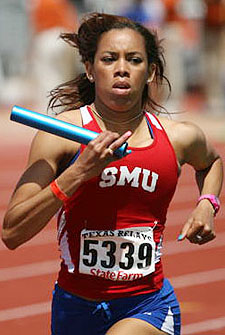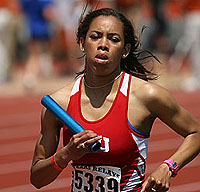 |
| Junior Amber Evans holds the all-time SMU records in the 60 meters and 100 meters, and has her sights set on claiming the 200 and 400 marks, as well (photo by Webmaster). |
|
When an athlete sets a record or reaches some kind of milestone, the accomplishment usually is accompanied by stories about intense effort and an unwavering focus on reaching that goal.
That’s not the case with Amber Evans … at least not in all events she runs. A junior sprinter on the SMU track and field team, Evans broke SMU’s all-time record in the 60-meter dash — for the third time — when she clocked a 7.64 Feb. 12 at Iowa State, beating her previous mark by two hundredths of a second.
Making the accomplishment even more impressive is the fact that Evans doesnΓÇÖt even really consider herself a sprinter. Female sprinters run the 60 during the indoor (first) part of the season, and the 100 when competition moves outside. Evans said she envisions herself as being better suited to running longer sprint events.
ΓÇ£IΓÇÖm naturally a 400 runner,ΓÇ¥ Evans said. ΓÇ£But if you run the 100, you make your 200 stronger. If you run the 200, you make your 400 stronger.
ΓÇ£I was surprised (to break the record in the 60), because I didnΓÇÖt really take it seriously. With my body type, IΓÇÖm not really that quick. IΓÇÖm built perfectly for the 400; 100 runners are usually stronger, more muscular.ΓÇ¥
Evans enjoys the 200 and 400 more than the 60 (indoors) and the 100 (outdoors), and says she is more of a natural in the longer events. But it is the two shorter sprints in which she holds the SMU records … at least so far.
EvansΓÇÖs claim that sheΓÇÖs ΓÇ£really not that quickΓÇ¥ is a modest self-analysis. Tony Miller coaches the SMU sprinters, and he said quickness isnΓÇÖt an issue with Evans. According to Miller, Evans is best suited to the 200 and 400 because of her lean frame, not a lack of quickness.
Running the longer sprints, Miller said, requires a rare athlete who enjoys the torture of sprinting for long distances, and the training that the event requires. Miller knows first-hand what goes into training for the events; he ran the long sprints with former Olympian Michael Johnson when the two were teammates at Baylor.
ΓÇ£Very few 400 runners are made ΓÇö theyΓÇÖre born,ΓÇ¥ Miller said. ΓÇ£They have to be blessed genetically with the body to run it. They have to want it. They have to love the pain, the lactic acid. I was that way ΓÇö if it didnΓÇÖt hurt, I didnΓÇÖt want to run it.ΓÇ¥
Evans said she has the same mentality. If she doesnΓÇÖt tax her body to its limits in training, she feels doesnΓÇÖt feel satisfied.
ΓÇ£If I donΓÇÖt leave practice feeling like I canΓÇÖt walk, I didnΓÇÖt have a good day,ΓÇ¥ Evans said. ΓÇ£When I go home after an awesome workout, I have to recoup."
Miller said that part of his job in helping Evans become even stronger in the longer events she prefers was convincing her of the importance of training for the shorter events.
ΓÇ£In order to be a good 200/400 runner, her 100 time has to improve,ΓÇ¥ Miller said. ΓÇ£SheΓÇÖs extremely fast, but sheΓÇÖs really a finesse runner ΓÇö she doesnΓÇÖt have the power to be that explosive.
ΓÇ£If she can add 10 or 15 pounds of muscle, she can get even faster, because her raw foot speed is as good as anybody in the country. With the way sheΓÇÖs built, weΓÇÖll see if she can add that much muscle, but if she can, she can go faster.ΓÇ¥
Miller said that if Evans embraces the shorter sprints, she could knock even more time off her school record.
ΓÇ£She could run in the 7.5s or 7.4s if she got excited about it,ΓÇ¥ Miller said. ΓÇ£But she sees herself as more of 2/4 (200 meters and 400 meters) athlete. You look at AmberΓÇÖs stature, and sheΓÇÖs built for the 200 and the 400. SheΓÇÖs not a big, muscular, powerful sprinter like Isis Wilson.ΓÇ¥
The sheer size of the SMU roster hampers the Evans and her teammates train. While sprinters at some schools can focus on events of one or two distances, the Mustang sprinters often have to run multiple events on the same day.
ΓÇ£When we go to meets, IΓÇÖm usually exhausted,ΓÇ¥ Evans said. ΓÇ£If I run two open events and the (4x400) relay, thatΓÇÖs six events in one day, with preliminaries and the finals. If I only ran one event, I believe I could be a national qualifier (in the 200 or 400). But we canΓÇÖt do that.
ΓÇ£Look at Texas A&M ΓÇö they have 53 sprinters on their roster. We have six.ΓÇ¥
ΓÇ£We have to ask her to do a lot, because of the size of our team,ΓÇ¥ Miller said. ΓÇ£If we were deeper, if we had the ability to take each kid and focus on one or two events, that would be different. But with the (lack of) depth we have, we canΓÇÖt do it. We donΓÇÖt have that luxury.ΓÇ¥
Nevertheless, Evans has her sights set on improved performances, as a team and individually.
ΓÇ£SMU has never won a Conference USA title, because weΓÇÖre a small team,ΓÇ¥ Evans said. ΓÇ£Houston has a big team, like A&M. UCF is the same way. So if weΓÇÖre going to win conference (the C-USA Outdoor Championships will be held May 12-15 in Houston), we have to win our events. We canΓÇÖt just place and win the title. If we finish second and third in an event, thatΓÇÖs good, but if UCF wins the event and also gets fifth and sixth, theyΓÇÖll get all of those points.ΓÇ¥
Individually, Evans has her sights set on lowering her time in the longer sprints, perhaps even enough that she could get a chance to compete on the sportΓÇÖs biggest stage.
 |
| Amber Evans said she thinks the school records in the 200 and 400 are within reach ?ó?é¼?Ç¥ maybe even this year (photo by Webmaster). |
|
ΓÇ£If I can get my 400 down to 48 (seconds), itΓÇÖs my goal to go pro, like Sanya Richards (the youngest woman ever to break the 49-second barrier in the 400). It will take a lot of work, but I can. If I go pro, IΓÇÖm going to believe I can beat her. You have to assume you can beat who youΓÇÖre running against. You canΓÇÖt assume you canΓÇÖt win. When you step on the track, you have to think that youΓÇÖre going to win. If youΓÇÖre going to beat me, youΓÇÖd better bring it that day. The Olympics are a goal, too. That would be a dream ΓÇö maybe 2012, maybe 2016.ΓÇ¥
Evans said that in order to accomplish any of her goals, she still needs to show significant improvement, which she said will continue in part because of the way she eats and trains.
“I have changed my eating habits,” she said. “When I got here, I was thin, so I ate everything. Now I’m eating fish and chicken. You have to eat what you want to put into your body, and fish and chicken are pure energy … protein. They have no fat, either, and fat slows you down. I trained hard in high school — I was used to hard training. But when I got here, I was 98 pounds. I walked in (to the track office) and (distance coach) Cathy (Casey) thought I was one of her distance girls. Coach Miller put me in the weight room, and he challenged me. I’m up to 121 pounds now, and that 23 pounds I have put on is muscle.
ΓÇ£WeΓÇÖre a year-round sport. We practice from 2-5 p.m. every day ΓÇö out of season or in season. In season, the only difference is that we spend our weekends at meets instead of training. I run every day ΓÇö if I donΓÇÖt, I feel like IΓÇÖm slacking. When IΓÇÖm resting, I know somebody is running, so I feel like IΓÇÖm behind, and IΓÇÖm not going to settle for that.ΓÇ¥
Evans said her next goal is the school record in the 200 (the SMU record is 23.43, set in 2000 by Tracey Ball) and to earn a trip to the NCAA Championships (June 8-11 in Des Moines, Iowa) in the event.
ΓÇ£If I get to 23.3 (in the 200), I think that will get me to nationals,ΓÇ¥ Evans said. ΓÇ£But I want to win it, so IΓÇÖll have to run a 23.1 or 23.0. I donΓÇÖt want to just go ΓÇö I want to stand on a medal podium. I ran a 24 indoors, so I should be able to go 23 outdoors.
ΓÇ£I want to break two records every year. I got the 60 this year and IΓÇÖve got the 100 (11.74). I think I can get the 200 this year. I want the 400 this year. I believe I can do it, but I know it will be a lot of work.ΓÇ¥









